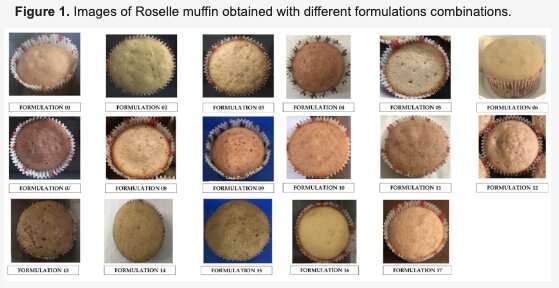Researchers tested different formulations of muffins containing a plant extract to see which variety appealed most. Credit: Screenshot from: Nutritionally Enriched Muffins from Roselle Calyx Extract Using Response Surface Methodology. Foods. 2022; 11(24):3982. https://doi.org/10.3390/foods11243982
Love muffins? We're talking about a tasty, fluffy muffin that has no artificial additives and that simultaneously contains lots of beneficial nutrients. As remarkable as it might sound, a recently published study describes the development of just such a new muffin in the journal Foods.
The new super muffin has been named Roselle, because it contains calyx extract from the tropical plant Hibiscus sabdariffa, which is often referred to by the same name.
Hibiscus flowers have a beautiful red color, and the calyx extract contains many valuable bioactive compounds, such as polyphenols, flavonoids, betaine and hibiscus acid. All of these components can be used to develop new products and functional food that may offer positive health effects, possibly also reducing the risk of chronic diseases.
The study also shows that Roselle muffins maintain their freshness for up to six days at room temperature, but with so many beneficial qualities, chances are they will be long gone by then.
Professor Nutan Kaushik at Amity University in the state of Uttar Pradesh, India, points out the health benefits of antioxidants, especially when it comes to neutralizing free radicals, which can be an important contributing factor to serious illnesses.
Roselle is also rich in anthocyanins. This is a dye that can be dissolved in water and yields a red, pink, purple, blue, blue violet or violet color. The color of food has a strong influence on how appetizing we think it is.
Artificial dyes are often clearer and more intense than natural substances. But the demand for natural dyes is increasing because of the concern that artificial dyes are harmful to our health.
In the muffin study, 30 people tested a total of 17 recipe variants.
The aim was to find the best version of Roselle muffins relative to three important qualities:
- The muffin should should have a taste and texture that people like
- The muffin should have valuable nutritional properties
- The muffin should have the best possible shelf life without preservatives
The researchers measured and surveyed the test subjects' response to the pastry's color, appearance, aroma, texture, fluffiness, elasticity, freshness and chewing resistance. The researchers used the Response Surface Methodology, to model and analyze how the test subjects' reactions were affected by various factors. The aim of the method is to achieve the most positive response to what is tested.
In terms of nutrition, the results suggest that the hibiscus extract provides muffins with high levels of antioxidants like phenolics.
These are substances believed to be able to prevent processes in the body that can damage cell membranes or the genetic material in our cells. There are several thousand different phenols, most of which are found in fruit, juice, wine, cocoa, tea, coffee, vegetables, flax seed, whole grains and legumes.
The Roselle calyx extract obviously provides health benefits, but the muffin research is primarily good news for those of us who already eat muffins. Because there are some bitter tastes—figuratively speaking—in this muffin batter, in the form of unhealthy sugar, saturated fat and white flour.
Eva Falch is an associate professor at NTNU's Department of Biotechnology and Food Science, and a co-author on the study. She doubts that Roselle would be able to be classified as healthy in Norway.
"Roselle calyx extract is an underutilized resource, and the study primarily shows the potential of the plant extract. The researchers use the muffin as a model to say something about how ingredients and steps in the manufacturing process affect and change the properties of the final product," Falch says.
Classifications and health recommendations, as well as taste and food culture, vary between countries.
"In food cultures where baked goods like this are part of the daily diet, Roselle muffins can contribute to increased nutritional value. To make a healthy version, the whole composition should be as good as possible, with little sugar, salt, saturated fat, and so on," said Falch, who is also head of the NTNU Food Forum.
A next step could be to test this ingredient in products with a better nutritional profile, such as whole grain products, so that it can be part of a healthy diet. Professor Nutan Kaushik, says the findings have helped in getting the acceptance among consumers as well as regulators.
"Next, we plan to do study the health benefits on animal model and launch a start-up company," she says.
Shelf life was the third factor the researchers investigated. When dry and semi-dry baked goods such as biscuits are left for too long, they can deteriorate both physically and chemically. Muffins with a higher moisture content, on the other hand, are more vulnerable to bacteria, fermentation and mold. Mold and mold spores are destroyed by heat during baking, but as soon as the muffins are out of the oven, they are exposed to airborne mold spores. But Roselle keeps fresh without preservatives
Roselle muffins have no added preservatives. The beauty is that the antioxidant ascorbic acid is also found in the pastry. This is a chemical bond that can contribute to increased shelf life in food products. And when it comes to the effects of ascorbic acid on the human body, most of us know it by its common name, vitamin C. The tests showed that Roselle kept well for six days at room temperature, with no signs of mold or spores.
More information: Sengnolotha Marak et al, Nutritionally Enriched Muffins from Roselle Calyx Extract Using Response Surface Methodology, Foods (2022). DOI: 10.3390/foods11243982
Provided by Norwegian University of Science and Technology
























